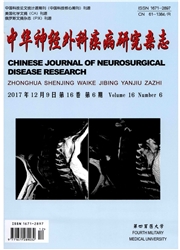

 中文摘要:
中文摘要:
目的:探讨九节龙皂苷对胶质瘤SHG-44细胞潜在的治疗作用及其机制。方法:用四基偶唑蓝(MTT)法检测5、7.5、10、12.5、15、20、40、80mg/L九节龙皂苷作用6、12、24、72h对人胶质瘤SHG-44细胞活性的影响和细胞流式术检测SGH-44细胞调亡情况;Hoeehst33258荧光染色法观察细胞形态的变化;琼脂糖凝胶电泳检测SHG-44细胞DNA的完整性。结果:九节龙皂苷明显抑制SHG-44细胞生长活性呈浓度-时间依赖性,并诱导细胞发生明显的凋亡,细胞核发生浓聚边集,DNA呈凋亡特异性“梯状”分布。结论:九节龙皂苷明显抑制SHG-44细胞的生长活性,能引起胶质瘤细胞大量凋亡,具有显著的抗肿瘤作用。
 英文摘要:
英文摘要:
Objective: To study the potential therapeutic effects ofsaponin ardipusilloside on human glioma SHG-44 cells. Methods: Methyl thiazolyl tetrazolium (MTT) assay was performed to measure the effects on the proliferation of SHG-44 cells treated with ardipusilloside at the concentrations of 5,7.5,10,12.5,15,20,40, 80mg/L for 6, 12, 24 and 72 hours. Flowing cell microspectrofluorimetry was use to examine the apotosis of SGH-44 cells. Hoechst 33258 fluorochrome stain assay was used to observe the morphologic change after treatment. DNA agarose gel electrophoresis was used to detect the integrality of DNA. Results: Ardipusilloside significantly inhibited the cell viability of SHG-44 cells in a concentration- and time-dependent manner and induced SHG-44 cells apoptosis characterized by the concentrated cell nucleus and ladder-pattem DNA. Conclusion: Ardipusilloside could effectively suppress the cell viability of glioma SHG-44 cells and induced it apotosis. The anti-cancer bioactivity suggested its prospect of management for human glioma.
 同期刊论文项目
同期刊论文项目
 同项目期刊论文
同项目期刊论文
 期刊信息
期刊信息
